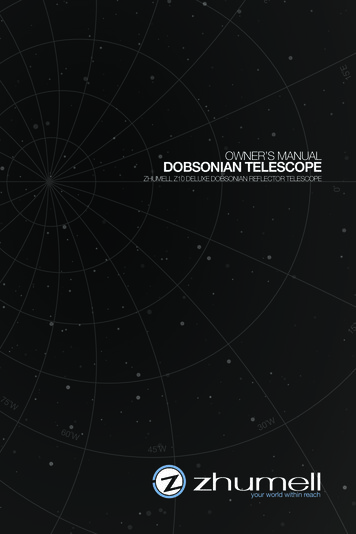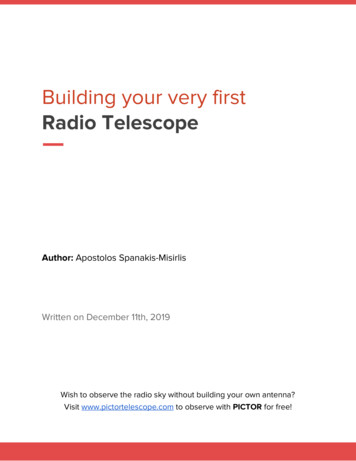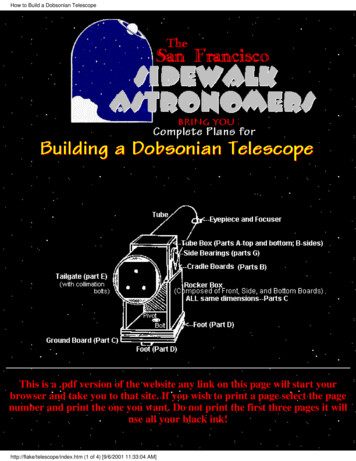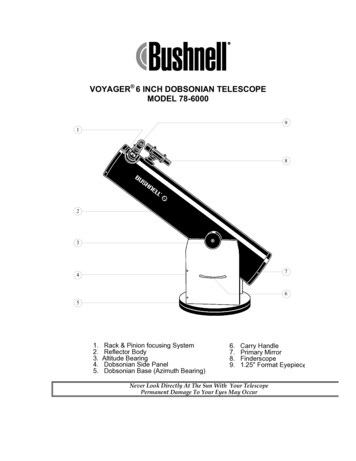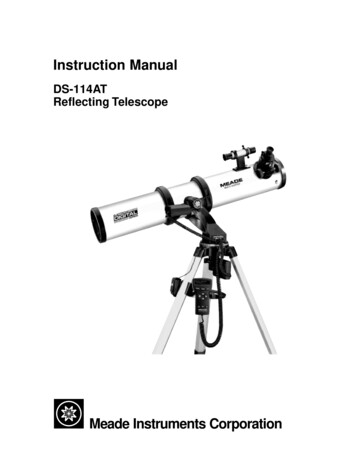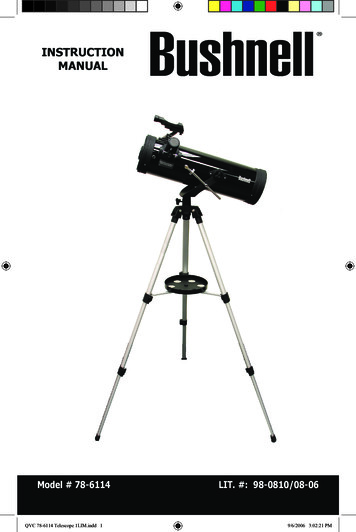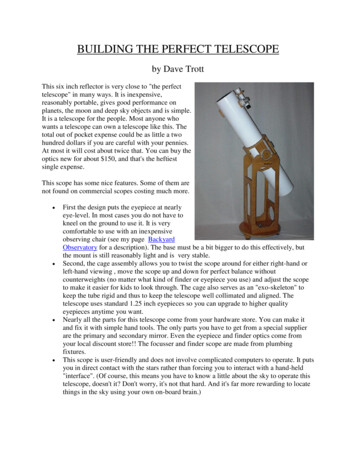
Transcription
BUILDING THE PERFECT TELESCOPEby Dave TrottThis six inch reflector is very close to "the perfecttelescope" in many ways. It is inexpensive,reasonably portable, gives good performance onplanets, the moon and deep sky objects and is simple.It is a telescope for the people. Most anyone whowants a telescope can own a telescope like this. Thetotal out of pocket expense could be as little a twohundred dollars if you are careful with your pennies.At most it will cost about twice that. You can buy theoptics new for about 150, and that's the heftiestsingle expense.This scope has some nice features. Some of them arenot found on commercial scopes costing much more. First the design puts the eyepiece at nearlyeye-level. In most cases you do not have tokneel on the ground to use it. It is verycomfortable to use with an inexpensiveobserving chair (see my page BackyardObservatory for a description). The base must be a bit bigger to do this effectively, butthe mount is still reasonably light and is very stable.Second, the cage assembly allows you to twist the scope around for either right-hand orleft-hand viewing , move the scope up and down for perfect balance withoutcounterweights (no matter what kind of finder or eyepiece you use) and adjust the scopeto make it easier for kids to look through. The cage also serves as an "exo-skeleton" tokeep the tube rigid and thus to keep the telescope well collimated and aligned. Thetelescope uses standard 1.25 inch eyepieces so you can upgrade to higher qualityeyepieces anytime you want.Nearly all the parts for this telescope come from your hardware store. You can make itand fix it with simple hand tools. The only parts you have to get from a special supplierare the primary and secondary mirror. Even the eyepiece and finder optics come fromyour local discount store!! The focusser and finder scope are made from plumbingfixtures.This scope is user-friendly and does not involve complicated computers to operate. It putsyou in direct contact with the stars rather than forcing you to interact with a hand-held"interface". (Of course, this means you have to know a little about the sky to operate thistelescope, doesn't it? Don't worry, it's not that hard. And it's far more rewarding to locatethings in the sky using your own on-board brain.)
YOU CAN BUILD THIS TELESCOPEThis is a six inch Dobsonian reflector. Many ordinary people have built simple telescopes likethis. See my Homepage at www.davetrott.com for pictures of a few of them. Before you decideto take on such a task you should read everything you can about the project. I am working on aweb-book that will help and there are many other web pages to check out. I'd highly recommendthat you read the books Build Your Own Telescope by Richard Berry and Making and EnjoyingTelescopes by Miller and Wilson. You should also know that you can buy a telescope much likethis for about 400 or 500. If you are interested in building any kind of telescope, I suggest youtake a look at the rest of this page. Even if you don't build this particular telescope you mightfind some helpful and money-saving ideas you can use.FOCUSERThe focuser for this telescope is a simple helical focuser. It works well and costs very little tobuild. All you have to do is find some plumbing fittings like these on the left. These PVC fittingsare designed to screw together. NOTE: make sure they screw together freely with no binding.The smaller, inner fitting must be large enough to accommodate the 1 1/4" brass drainextension. Use some masking tape to fit the 1 1/4" fit snugly inside it. Cut the PVC fittings sothat the only remaining part of the inner section is its threads. The larger fitting must be cut sothat the smaller fitting will go into it from the direction opposite that intended by its design.Mount the assembly on a curved piece of hardwood with a nice big hole in the middle. In the leftpicture the inner section of the completed focuser is pictured for clarity. The 1 1/4" ID section ofthe brass tube must be accessible from the outside since that is the standard size for goodeyepieces. You might want to cut a couple of slits in it as shown so that it will grip an eyepiece.
SECONDARY MIRROR SUPPORTThe secondary mirror mount is unusual. Manyscopes use a fairly complicated device called aspider, with four vanes that attach to the tubein four places and support a special devicecalled a secondary mirror holder. This is a finesystem. But it's complicated to build andexpensive to buy (about 50). The system Iused is not new. I copied it from some veryold books and updated it slightly. It is simple,robust and effective. It is a bit more difficultto adjust, but once properly adjusted shouldhold the adjustment indefinitely. Telescopemaker purists will object to the thick 1/4 inchsingle support bolt. But it really does notintroduce very much diffraction and is auseful compromise for a first telescope. Thethickness of the bolt makes it very strong andsteady; no vibrations in this secondary!I recommend a slightly oversized secondarymirror for this telescope. Use a 1 1/2"secondary if this is your first telescope. Theextra large secondary mirror will allow forless-than perfect construction.To attach the secondary mirror: Buy a small tube of silicone glue and attach your secondarymirror to a 45 degree angle piece of steel drilled to accept a 1/4' bolt. (Make this by bending anordinary steel corner-brace to 45 degrees). Attach by placing the secondary face down on severallayers of Kleenex and laying a thick bead of silicon glue on the back of the mirror. Be sure to getthe placement right, with the proper amount of overhang. (See the diagram in the plans below.)Be careful not to touch the front mirror surface.To assure yourself that the mirror will always stay attached, give this assembly the "shake test"after it cures over night. Attach it to a long bolt, place your entire hand and the secondaryassembly inside a plastic trash bag and shake the assembly violently. Try not to allow the mirrorsurface to touch anything during this test. If the mirror comes off now it won't be a majordisaster. It would be very unfortunate if that were to happen later after it is installed in thetelescope, when the primary mirror is in place.
CAGE ASSEMBLYThe cage assembly is actually two separate pieces which are held together by four long pieces ofthreaded rod. They must be made so that they compress the tube between them. This is whatholds them in place. The side bearings are made of four-inch PVC drains. The picture on thebottom right shows one of the pieces dismantled. The curved pieces must be covered with felt sothey don't scratch the tube. Inexpensive sheets of self adhesive felt are available in the "chairfoot-pad" section of your hardware store.
PRIMARY MIRROR CELLThe mirror cell is very simple. It's made of a couple of pieces of plywood. The mirror is held tothe top piece by three mirror clips made of angle braces from the hardware store straightened in avice and re-bent at the proper distance. The mirror is held in place with self adhesive felt pads atevery contact point. The mirror must be cradled with no excessive pressure. The top piece ofplywood has three long bolts protruding from it. These three bolts pass through springs andthrough the rear, triangular plywood section. Wing nuts pull on these bolts allowing theadjustment of the tilt of the forward plywood disk and thus the mirror. This is necessary for theadjustment of the telescope. See the plans for more detail.
Some of the parts needed to build this telescope.THE FINDERBefore you make a decision to build your finderaccording to these instructions think about this: Youcan buy a Telrad finder (pictured) and inexpensivecommercial eyepiece for about 80 total. This option ismuch easier than dissecting a cheap pair of binocularsto build your own finder and eyepiece. Though thefinder you build will work fine, the Telrad is the bestfinder for any telescope. It is very simple and easy touse. The build-it-yourself option will cost about 35total. And the Telrad finder (pictured at left) is farsuperior to the finder you will build and is therecommended finder for ALL telescopes of any price. If I were building this scope as my firstscope, I'd opt to spend a bit more and get the Telrad.The finder for this telescope is made of the front lens element of a cheappair of 7x35 binoculars. Get hold of an inexpensive or broken pair ofbinoculars. They must be 35mm to use this design, though with someingenuity you could adapt it to any size. You can buy a pair of binocularsfrom a discount store for 20.00 ( look for the kind with a "Z" shape toeach barrel - these are prism style binoculars. Do not buy one in thisprice that is composed of two straight tubes - these are Galillean or"Opera Glasses" and are a rip-off and won't work.). Never destroy a pairof good quality Zeiss, Leica, Swarovski or other name-brand binocularsfor this purpose. The expensive ones are worth fixing! Remove one ofthe primary lenses. Sometimes these will simply unscrew but often you
will have to cut away the plastic housing with a hack saw.Usually, even the cheapest binoculars sold to adults contain two useful eyepieces. A binoculareyepiece will have a fairly long focal length (usually 25mm or so) which will give you lowpower in your telescope.(LOW power is a desirable trait, believe it or not!). You can use one inyour finder and one in the main telescope.First, use whatever skils you have to remove the eyepiece from the binoculars without doing theglass portion any harm. Often you can just cut the supporting aluminum arm with a hack saw.File any sharp edges, being careful not to get any shavings into or onto the eyepiece. Buy some1.25" OD drain tube at your hardware store. You should be able to wrap masking tape aroundyour eyepiece until it fits snugly into a short section of this tube. If not you will have to usesome ingenuity to make the eyepiece slide into a 1.25" tube and be removable. If you can do thisyou have two inexpensive 1.25" telescope eyepieces, one for your finder and one for the maintelescope. Of course, you'll be lucky to find one that slips into your star diagonal. If it doesn't fityou'll have to use some tape and/or plumbing fixtures and/or ingenuity to fit your eyepiece to thestar diagonal. Find a simple way to fit the eyepiece using some tape or whatever.Once you have a 35mm binocular objective, get a 1.5" plastic drain tube extension and a 1.25"plastic drain tube extension. The 35mm lens should slide into the 1.5 inch adapter and stop where
it narrows. You can cut a short piece of the tube off and use it as a spacer to hold the lens inplace using the included friction nut. Then with one of your eyepieces installed in the 1.25"adapter you should be able to slide the small diameter 1.25" tube into the small diameter 1.5"tube until the mini-telescope forms an image of a distant object. Be patient , this will take someexperimentation. You will probably have to cut one or both of the tubes shorter to make thetelescope focus. Try it with the eyepiece and the 1.5" tube by themeselves. That will give yousome idea of the proper distance. Use some masking tape or scrap plastic tube as a bushing tomake the tubes fit snugly. DO NOT GLUE THEM TOGETHER. You need to be able to slidethem back and forth for focus. The finder rings are made of 3/4 inch solid hardwood, cut toshape, drilled and tapped for the adjusting bolts. If you are obsessive paint the inside flat black.The ground board and the base board must have teflon in contact with Formica or some otherbrand of plastic laminate. Rough surface Formica works best. Get some teflon pads at thehardware store in the chair leg section. The ground board is the one closest to the ground. It willhave some stubby feet at three points where it contacts the ground.
THE PLANSIf you are interested in building this telescope, check these next pages carefully.
RECOMMENDED PROCEDURES1. READ AND FOLLOW ALL SAFETY PRECAUTIONS WHEN USING POWER TOOLS!!!2. Always wear safety goggles.3. Wear a good dust mask when sanding.4. MEASURE TWICE, CUT ONCE: Double check every measurement before you drill or cut.5. Use 3/4 inch plywood. A nice appearance can be obtained with better wood. The best lookingfinish on the wood will be achieved with lots of sanding. When sanding large surfaces, alwayssand with the grain. Start with the coarse grades and proceed stepwise to the finest grades. Mostof the sanding should be done BEFORE assembly. For the tube; sand lightly with a fine gradesandpaper before painting. The tube is 8" cardboard concrete forming tube commonly called"Sonotube". Don't worry , IT IS strong enough. Paint it with good water/resistant paint; black onthe inside. Before you paint it, peel the thin plastic "skin" off of the interior of the tube. Start at acorner and gently lift. It should come off in one piece if you are careful. Paint the tube interiorflat black. Use a brush attached with duct tape (at about a 45 degree angle) to a two foot stick. Oruse a spray but don't breathe the vapors! Or make up your own, creative technique for paintingthe interior.6. Pre-drill all screw holes to prevent cracking. Countersink them for esthetics (if desired).7. Use screws for attaching wood to wood. Test your telescope thoroughly for a few monthsbefore gluing. Most people find that gluing the wooden pieces together is unnecessary.8. Use wood filler to fill any cracks or chips then sand the patches smooth.9. Water-based polyurethane products varnish will allow you to work fast and produce abeautiful finish on wood surfaces. Sand and stain first, of course. I suggest a light coat of stainfollowed by two to four coats of gloss (or satin) polyurethane. Using a very fine (400 grit)sandpaper between coats will give a super smooth appearance.10. If you match your trim pieces (knobs, handles, bolts, etc.) in brass they will add a classytouch to your telescope.11. Put a dot on your primary mirror. Place the mirror face down on a sheet of paper and tracearound it. Cut out the circle and fold it in half. Turn the paper 90 degrees and fold it again. Cut1/8 inch off the tip of the corner at the center of the circle. The result should be a circle you canlay GENTLY over the surface of the mirror which covers it completely and has a small holedead center. When you are SURE you have located exact center, place a small, 1/4" circular dotof white paint directly on the surface of the mirror. Remember, it must be DEAD CENTER!!!(THIS WILL NOT AFFECT THE PERFORMANCE OF YOUR TELESCOPE IN THESLIGHTEST!! It will be used later for precise collimation adjustment.)
12. (OPTIONAL) You may find it desirable to remove some of the material from the side boardsand/or the front board in order to lighten the mount a bit (as I did). This is not necessary. Youcan leave the side-boards solid. But if you find the mount a bit heavy, it's an opportunity tobecome creative with your jigsaw. If you do cut out any material, be sure to leave plenty of woodnear any attachment or support points. Mine is a bit extreme. Be more conservative than I was.Don't remove as much wood as I did.13. Paint the mirror cell and mirror cell support flat black.14. when you cut the holes for the focuser and secondary mirror assembly: carefully check theplans for placement of the holes. Cut a 1-3/4" to 2" diameter hole and an identical one oppositeit on the tube. This can be done with a hole saw, if you have one. If not, you can drill severalholes in a circular pattern and remove the remaining material with a sharp knife. Don't worryabout the appearance of the holes since they will be covered on the exterior of the tube by awooden mounting block.15. On the dimensions for your telescope:The philosophy to adopt here is to build from the inside out.The dimension of the side bearing box and the cradle box depend on the diameter of the tube youpurchase. Let's assume your tube is exactly 8 inches outside diameter (measure this!!!). If youlook at the diagram of the trunion box, you'll see that it has to enclose and grip the tube. So thetrunion box has to be the diameter of the tube plus about 1/4 inch plus the thickness of yourplywood (times two). Assuming your tube is 8" and your plywood is 3/4" (measure this!!!) thatwould give you an outside width of 9-3/4". The Rocker box inner width should be this dimensionplus about 1/2". giving you 11-3/4" for the outside width. The large circular pieces should beabout 18" in diameter. The height of the side bearing box should be about 32". This will give youa nice position for the telescope. If you don't like it that high, it's easy to make it shorter later on.Loosely assemble the entire rocker box assembly (using the nice piece of round wood for yourbase board) and outline the positions of the side and front boards in pencil on the top of the baseboard. Then drill nine holes within these lines. The screws to attach the side boards and frontboard will come back UP from underneath to attach these pieces to the base board. Wheneverything is properly fitted, assemble the rocker box.16. Test fit the curved sections of the side-bearing box to the telescope tube. They should be a bitloose and slip around the tube easily. If they aren't, you will have to remove material and sandthem until they are. Later you will attach felt to these curved sections. They must be fairly snugwhen the felt is attached. Referring to the plans and diagrams, assemble the side-bearing box.17. When you mount the secondary mirror assembly, be sure the center of the secondary mirroris lined-up with the axis of the focuser (see plans). Make sure the length of the threaded rod putsthe secondary mirror in the center of the tube (within 1/4 inch)
18. When you assemble the primary mirror cell and support, look at the diagrams for locations ofbolts and felt pads. Mount the primary mirror in its mirror cell and then in the tube. The locationof the primary mirror cell support is approximate and will work with most mirrors. If yourprimary is exactly 48" in focal length, then the distance from the center of the focuser hole to thecenter of the mirror cell support should be 45", as on the diagram. There are two options forattaching the mirror cell support: A. Put a screw through the tube wall into the mirror cellsupport 45" (triple-check this measurement!!) behind the center of the focuser hole, as shown inthe right side on the mirror cell diagrams. OR, B. (RECOMMENDED) You can obtain threecorner braces one to two inches long and attach them to the mirror cell support with bolts asshown in the left side of the mirror cell diagram. Then when you insert the mirror cell into thetube it will be easier to attach it to the tube with bolts from the outside. Using this option willrequire you to ADD THE HEIGHT OF THE HOLE IN THE CORNER BRACE PLUS 1/4" tothe 45 inch measurement (triple-check these measurements!!!). Make sure the center of themirror-cell support ends-up at 45 inches (for an f/8 system) behind the center of the focuser hole.If you drill holes in the wrong location for any reason, simply buy some pretty dummy bolts forthe unused holes. You can call these additional features on your telescope "Conductive CoolingBolts" (To help the telescope reach the proper temperature.) You are not lying either!!!FINAL ASEMBLY AND ADJUSTING THE OPTICSAfter the focuser is mounted but before you drill any holes for the secondary mirror assemblyyou have to adjust and mount the secondary mirror assembly. Here's what is needed: thesecondary mirror MUST looks directly at the center of the primary mirror (where there is a dot,remember?). This is such a confusing view when the primary mirror is in place that I recommendyou perform this adjustment before you mount the primary mirror cell assembly in the tube.Cut a couple of 12" lengths of string and tape them to the back end of the telescope such thatthey form a "cross hair " which is perfectly centered in the telescope tube. Then go to the focuserand look down the tube. Make a long 1 1/4" empty tube out of some cardboard or plumbing pipe.Make sure it has no sharp edges near the eye end of it. Put it into the focuser. Back away fromthe focuser KEEPING YOUR EYE DEAD CENTER on the optical axis of the focuser so thatyou see all the interior of your long tube equally all the way around.Next, you must adjust the secondary mirror so that it is nearly centered in your view AND itreflects the "cross hair" dead center in your view. You may have to slide the secondary assemblyforward or back and /or shim it (or bend the threaded rod a bit) so that when it is finally mountedthe cross-hair is perfectly centered when your eye is perfectly centered on the optical axis of thefocuser. Don't worry if the secondary is not, itself, perfectly centered as long as it's close tocenter. There is a little extra flexibility because your secondary is oversized. But the cross-hairmust be DEAD-ON. When you finish this step, take your long collimation tube out, put your eyeup to the focuser and check to see that you can see the entire opening at the back of the tube. Ifnot you'll have to adjust the POSITION of the secondary, then go through the process ofadjusting the aim of the secondary again from scratch. Only when this is perfect should you drillholes and mount the secondary assembly. Tighten the nuts securely and re-check everything.
When you have the secondary mounted and are SURE it's perfectly lined up on the "cross-hairs"remove the strings and install the primary mirror assembly. Next you will collimate your primarymirror using the three bolts at the rear of the telescope.PRIMARY MIRROR COLLIMATION STEPSStep 1 -- Look into your focuser (with no eyepiece in it). You should be able to see the secondarymirror and, in it, a reflection of the primary mirror with it's central dot. If you do move to Step 3.Step 2 -- If you don't see the primary mirror then you'll have to adjust the secondary mirror untilyou do. With the tube in a horizontal position (so you don't break the primary should youaccidently drop the secondary) perform whatever adjustments are necessary until the primary isreflected in the secondary. You may have to GO BACK SEVERAL PARAGRAPHS TO THEStep 3 -- Make sure the central dot on the primary is in the center of your eyepiece tube. Backyour head away from the focuser keeping your eye on axis by making sure the eyepiece tube isperfectly concentric. (Don't worry if the secondary mirror is a bit off-center. The only importantfactor on that issue is that the eyepiece be able to "see" the entire primary.) If the center dot onthe primary is not perfectly centered in the eyepiece tube you must adjust the secondarymounting so that it is. You may have to SLIGHTLY adjust the secondary.Do this CAREFULLY! It may take several tries before you get it perfect.Step 4 -- This is fairly easy and may have to be done frequently even on a well constructedtelescope. (See the illustration in the plans section for clarification as well as this photo.) Lookto see that the reflection of your eye in the primary is dead center on top of the central dot on theprimary. For precision you should use a collimating tool (a 35mm film container with it's bottomcut out and a 1/8'' hole in the center of it's lid works fine) to make sure your eye is centered in thefocuser tube. Use the tool only after you make sure you are "close" without it, otherwise you losethe center dot before you get started. It is easiest if you have a friend adjust the three primaryadjustment nuts or bolts (after loosening any "locking" bolts) while you watch through theeyepiece until the center dot is right in the middle of the reflection of your pupil.Step 5 -- STAR TEST: This is the acid test of telescope performance. Center a medium brightstar (Polaris is perfect) in your medium power eyepiece. Then move the focus in and out pastperfect focus. On either side of focus you should see identical systems of little concentric rings
around the star (perhaps 3 or up to 15). If they wobble around, that's just the atmosphere, don'tworry.If they are identical and circular you have a perfectly adjusted scope. If not you may haveto make more refined adjustments. It is also possible that this STAR TEST will show bad optics.This test is so sensitive that to pass it requires that your mirror be exactly the same temperatureas the air! It may require you to put the telescope outside for half an hour before even attemptingthe STAR TEST. If your telescope seems to fail the STAR TEST do not panic. See if you can getan expert (a member of your local astronomy club, perhaps) to look at it. If your telescope passesthe test BE HAPPY!!SPECIAL NOTE: Telescope mirrors sometimes have slightly different focal lengths. THIS IS ANORMAL VARIATION and should not cause you any serious problem or concern. You mayhave to adjust the position of the primary mirror assembly at a later time. You will recognize thissituation if your completed and assembled telescope will not focus on a star. This telescopedesign is intentionally VERY FLEXIBLE and allows such adjustments to be made easily. If youdo have to move the mirror cell support, simply use three dummy bolts in the old holes (topreserve the aesthetics of the tube), drill new holes further back or forward of the old holes. Theamount that you need to move the cell can be estimated by test focusing your telescope. You willbe able to tell if your mirror is "short" or "long" and by how much. You will probably not haveto make this adjustment.EYEPIECESYou will want some additional eyepieces to give you higher power. I suggest a set of threeeyepieces for beginners. A 20mm to 32mm, a 10mm to 15mm and a 4mm to 7mm. To learnmore about eyepieces, see The Backyard Astronomer's Guide by Dickenson and Dyer orStarware by Harrington. With 1 1/4" eyepieces you get what you pay for.
to make it easier for kids to look through. The cage also serves as an "exo-skeleton" to keep the tube rigid and thus to keep the telescope well collimated and aligned. The telescope uses standard 1.25 inch eyepieces so you can upgrade to higher quality eyepieces anytime you want.


